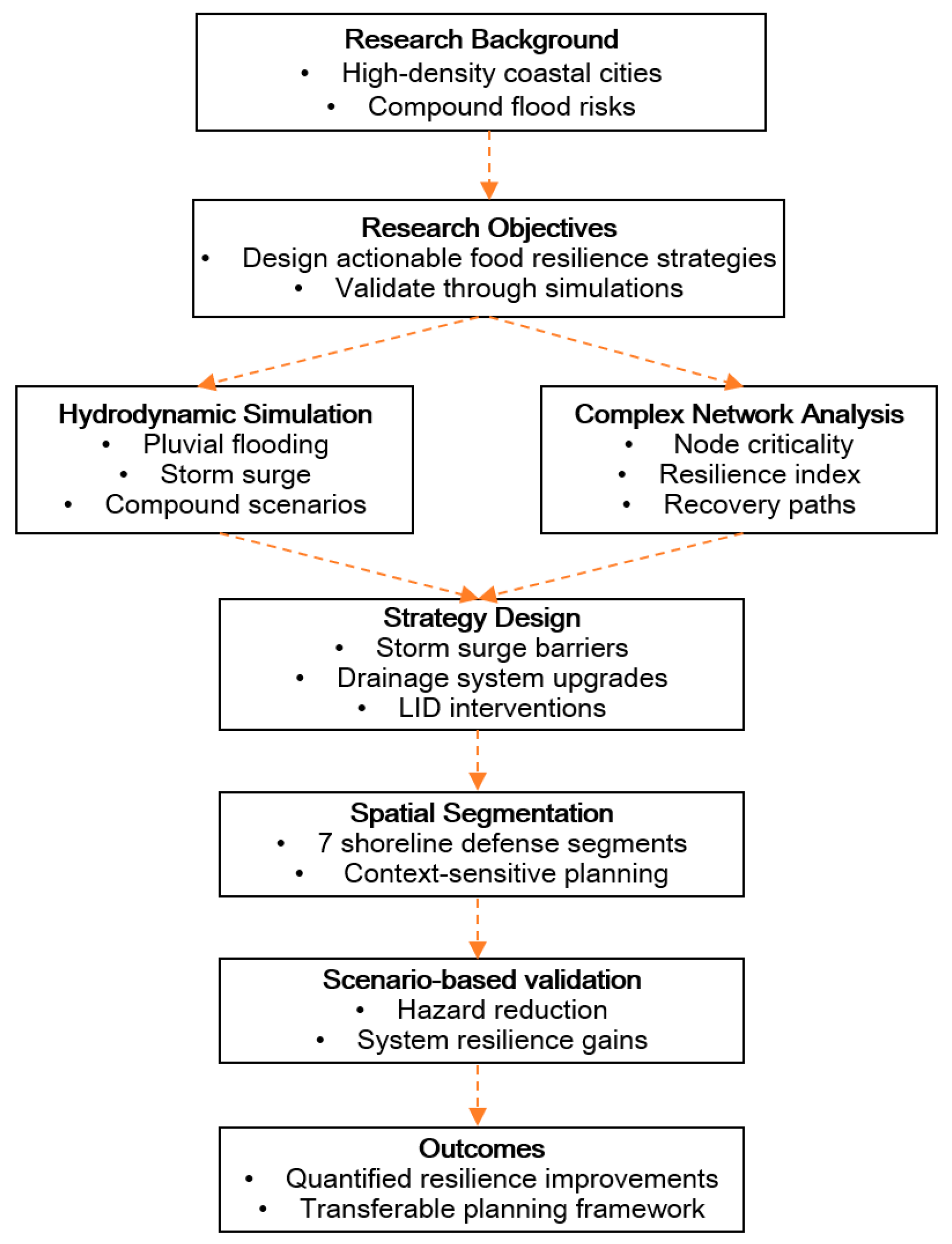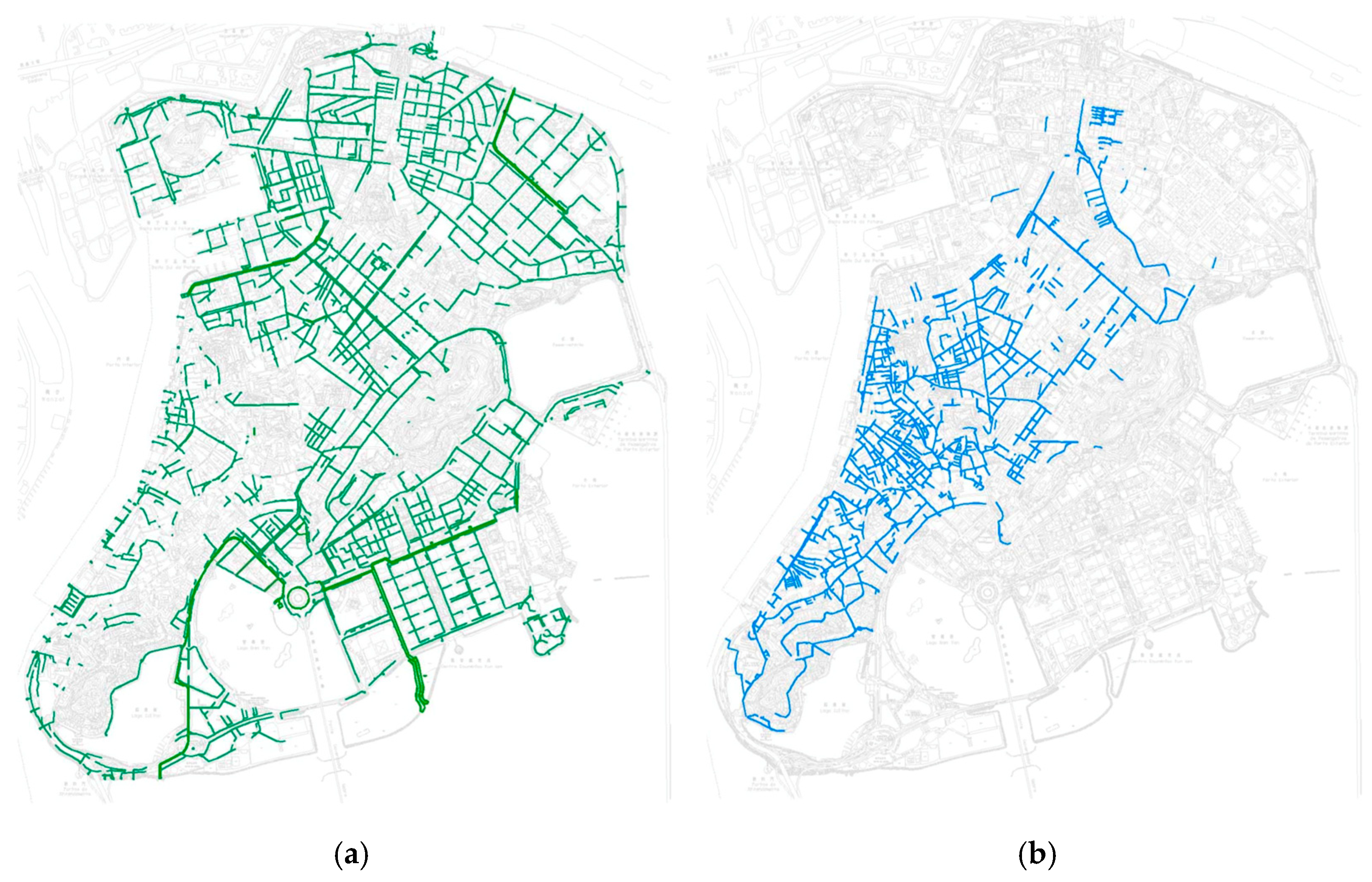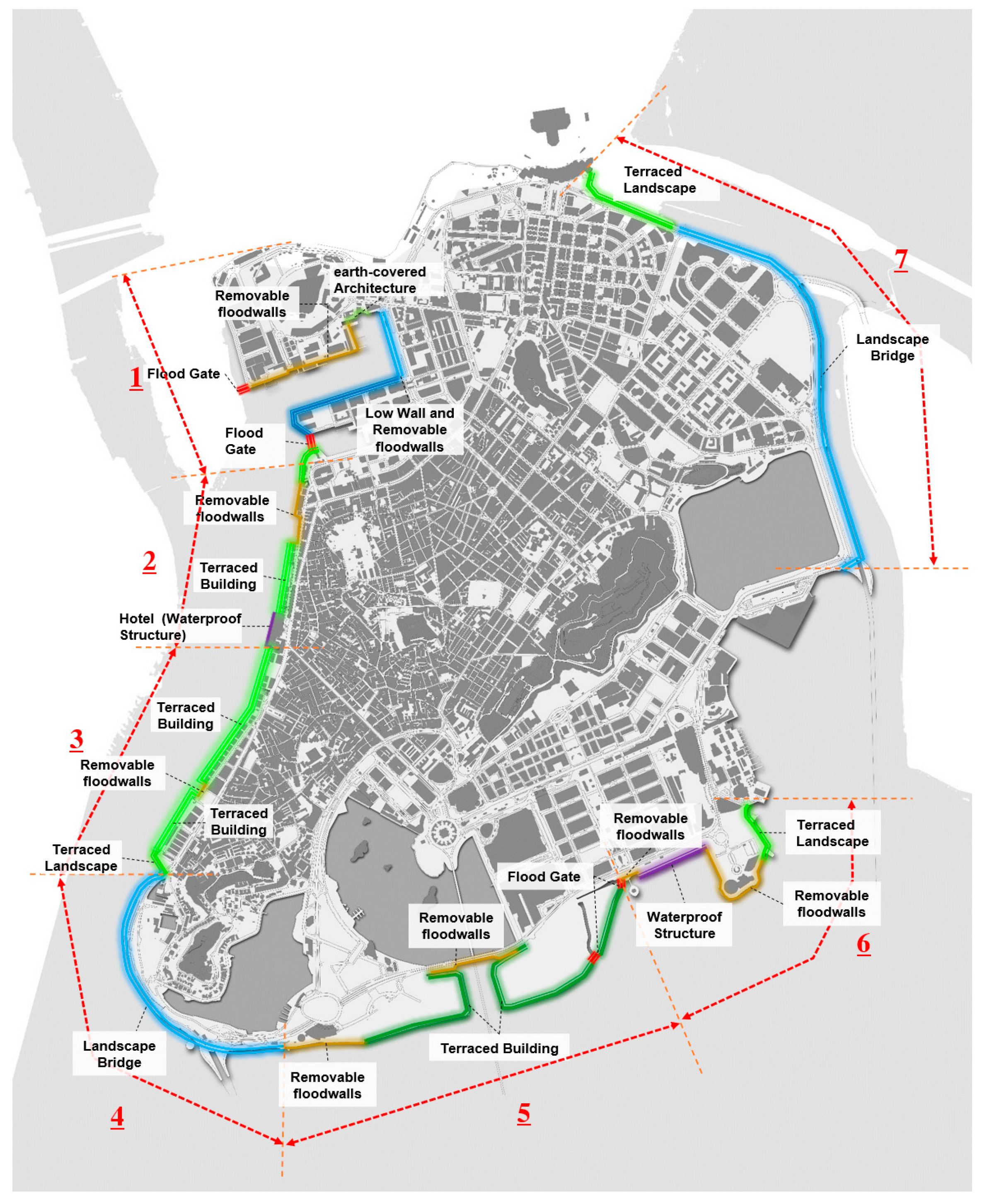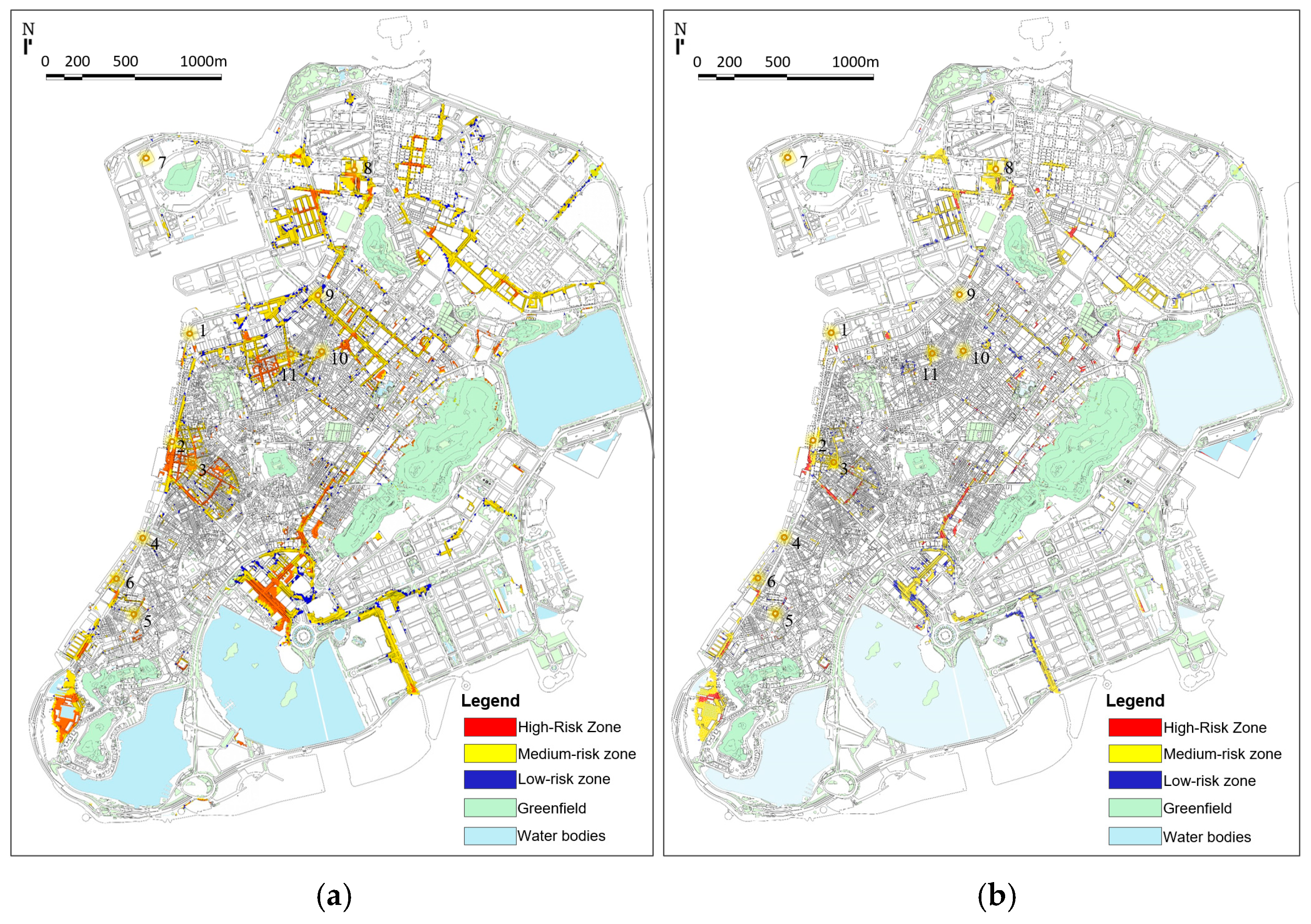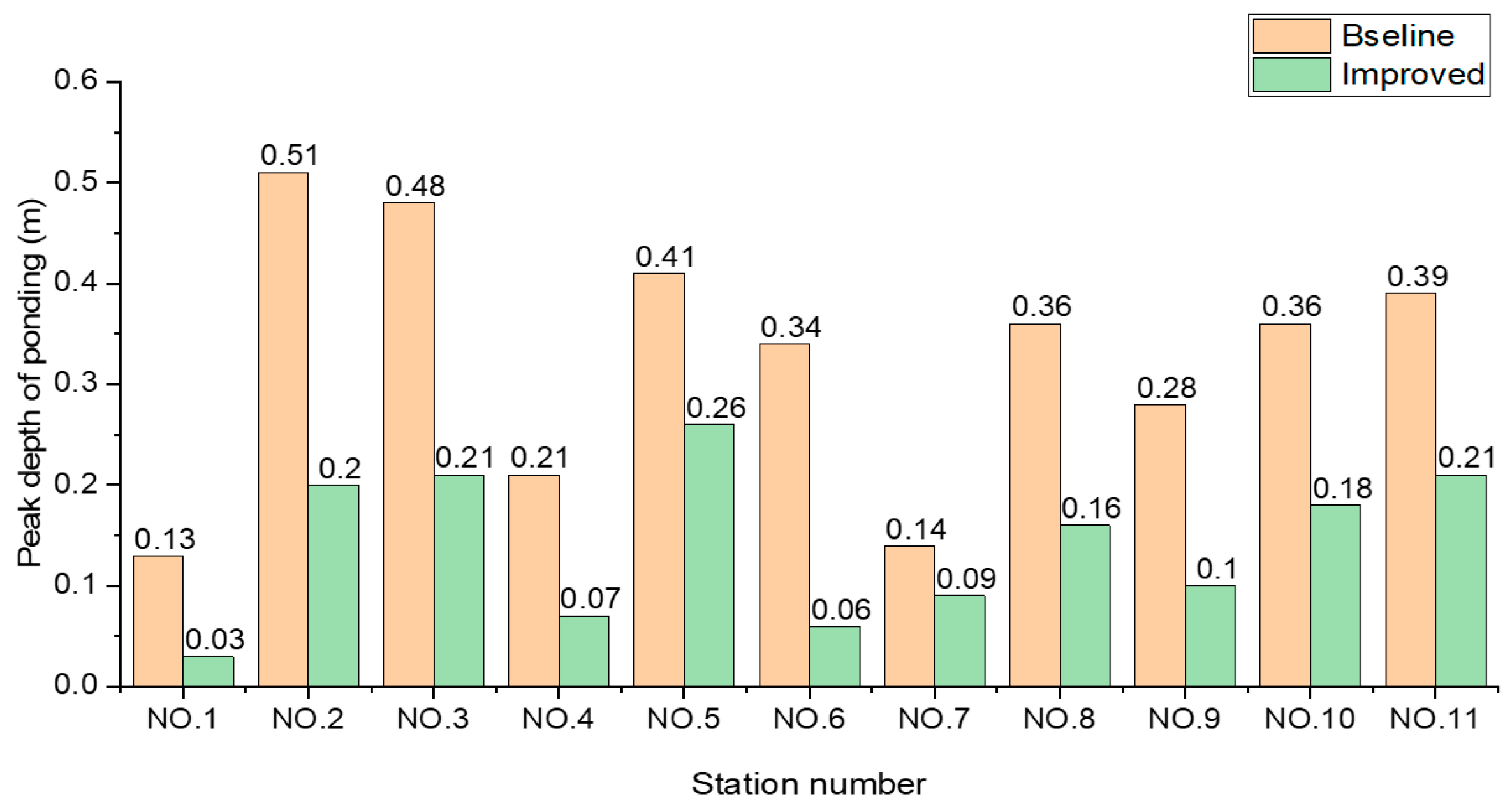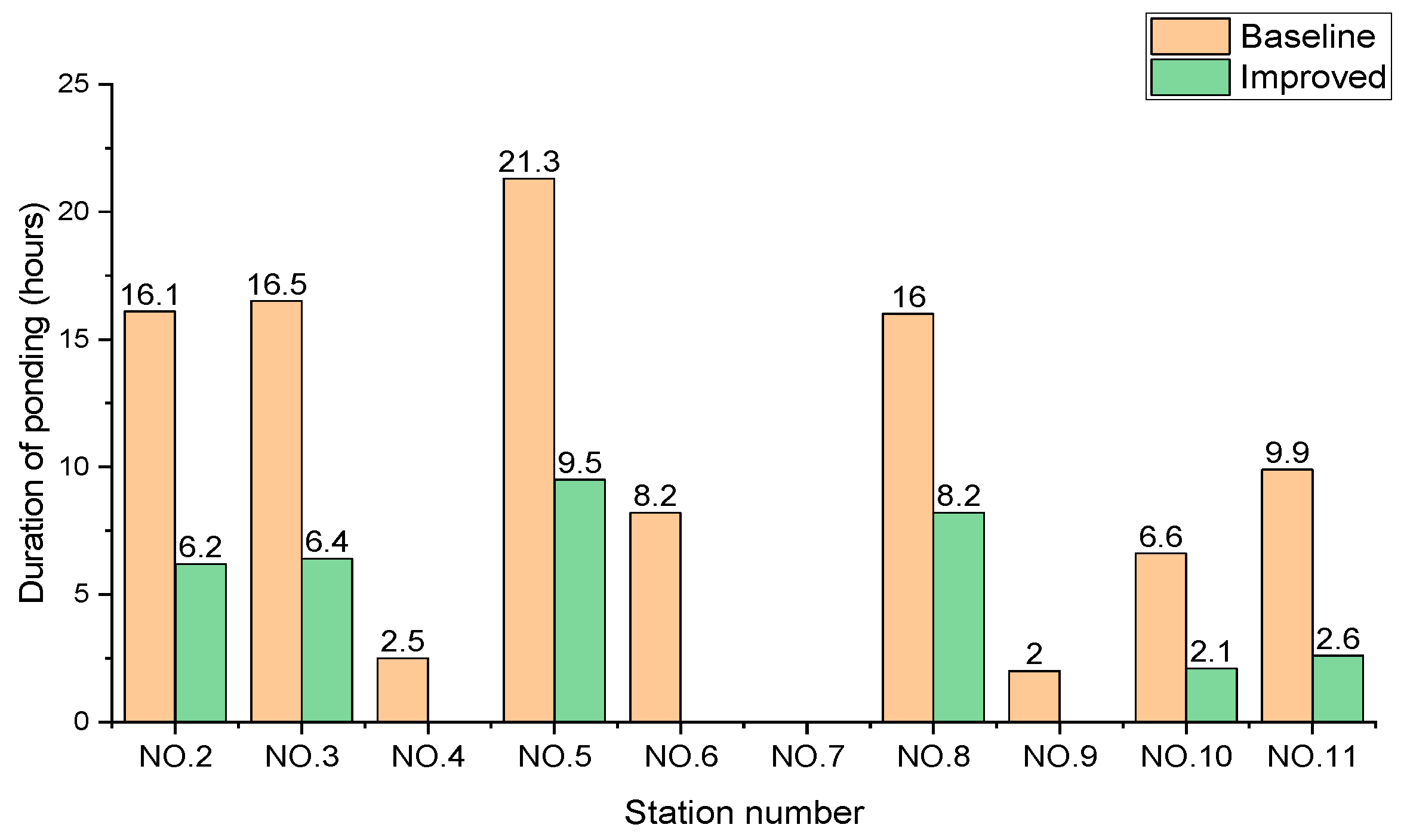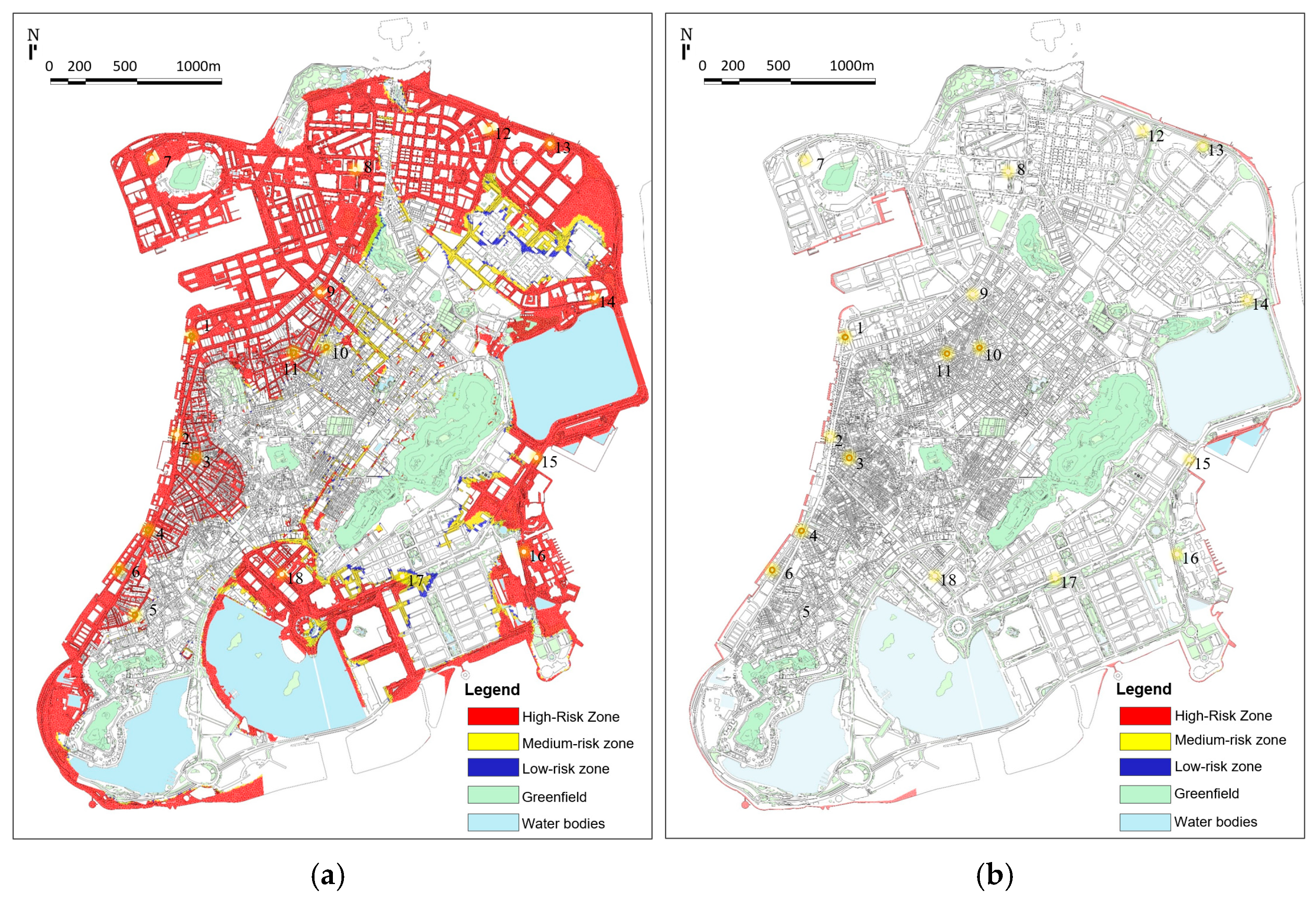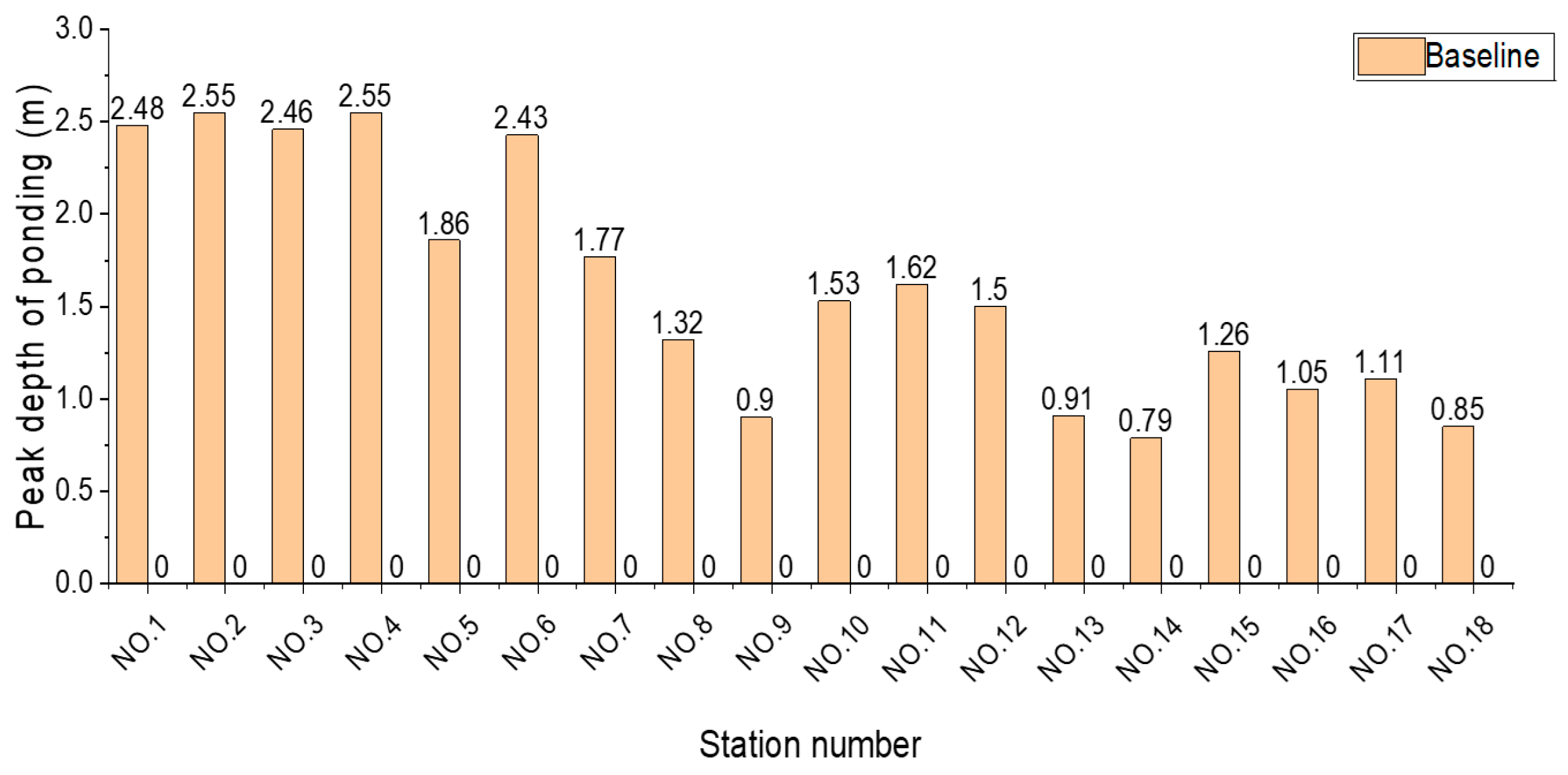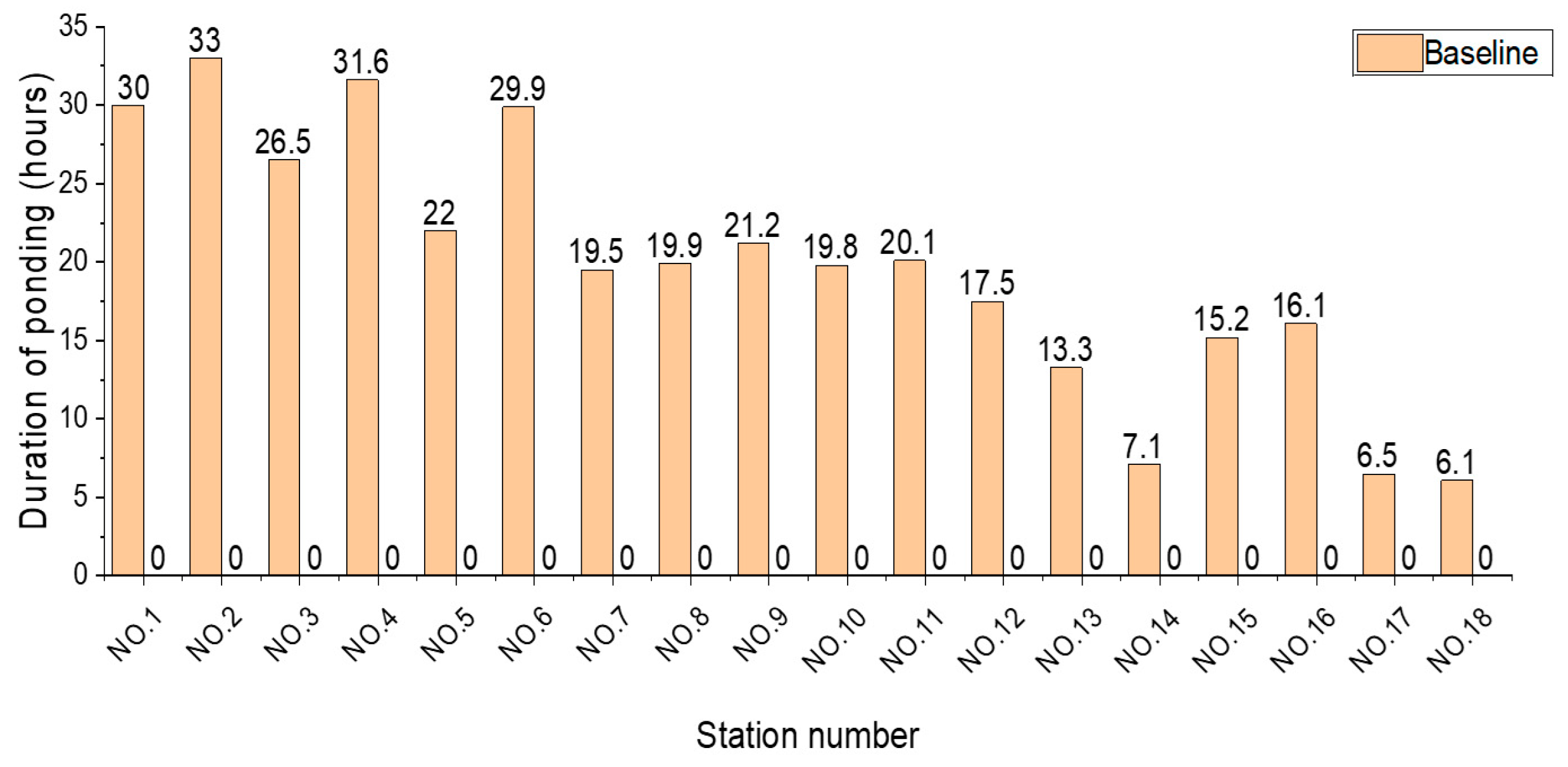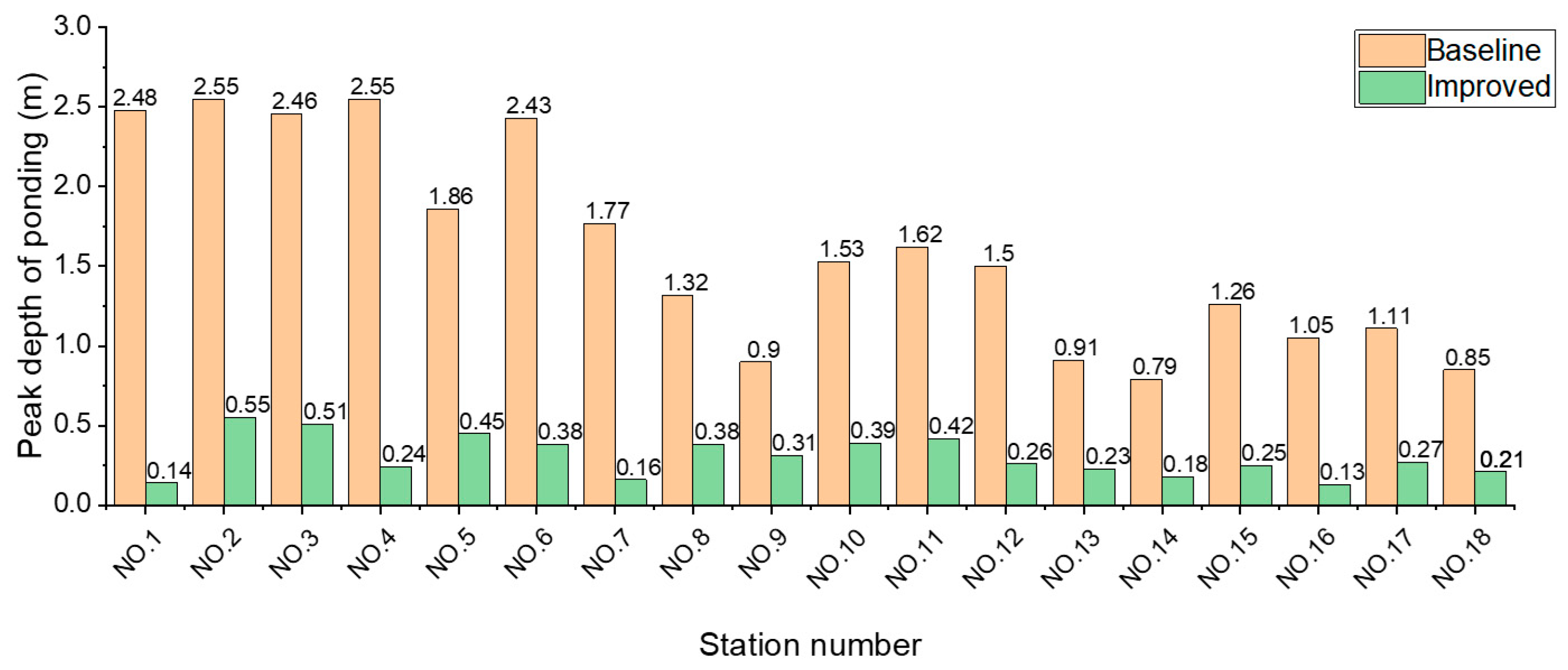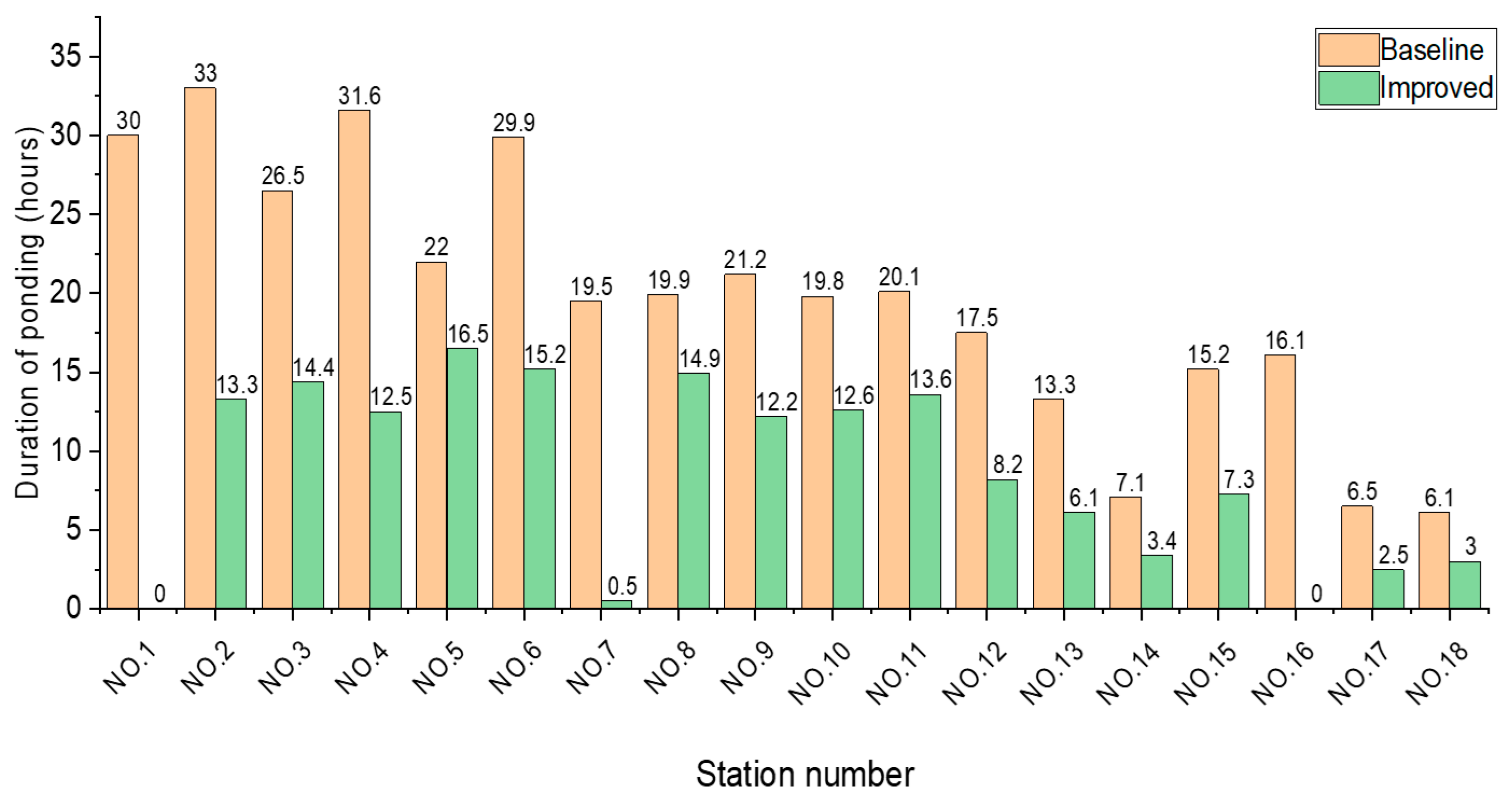1. Introduction
High-density coastal urban areas face escalating flood risks due to the compounded impacts of climate change, land-use intensification, and aging infrastructure systems. In particular, cities like Macau, characterized by extreme urban density, limited land resources, and extensive coastal exposure, are increasingly vulnerable to both pluvial flooding from extreme rainstorms and coastal flooding from storm surges. Recent severe flood events, such as those induced by the Typhoons Hato and Mangkhut [
1], have highlighted the deficiencies in the existing flood defense systems and underscored the urgent need for enhanced flood resilience measures in such urban contexts. However, the practical implementation of such strategies remains limited in high-density coastal contexts.
Over the past decade, scholars have developed various frameworks to enhance urban flood resilience, often grounded in integrated risk governance, distributed stormwater management, and adaptive spatial planning [
2,
3]. For instance, embedding decentralized stormwater into urban spatial design to reduce pluvial flooding is emphasized in recent cross-city reviews and BGI framework studies [
4,
5]. Similarly, risk-governance frameworks that integrate hazard, exposure/land-use vulnerability, and resilience for decision support have been updated and systematized [
6,
7]. Other works highlight a system-based resilience transition, beyond hard infrastructure to include early warning systems, community preparedness, and adaptive land-use planning [
8,
9,
10]. Notably, nature-based solutions such as sustainable urban drainage systems, green roofs, and vegetated swales have gained prominence as effective tools for reducing runoff while enhancing ecological and social co-benefits [
11,
12,
13]. Despite this progress, few studies translate these resilience concepts into spatially actionable strategies, especially for dense urban districts constrained by land scarcity and infrastructure rigidity [
14,
15].
In terms of modeling, substantial efforts have been devoted to flood risk identification through hydrodynamic simulation, remote sensing, and geospatial analytics [
16,
17]. Approaches include the application of source–pathway–receptor models to coastal urban settings [
18], the use of high-resolution flood simulations with 3D visualization to support stakeholder decision making [
19], GIS-based coastal hazard zoning for urban areas [
20], and the development of quantitative flood resilience evaluation frameworks that integrate pressure–state–response perspectives with advanced analytical methods such as rough set theory [
21]. Recent work, including a comprehensive flood risk assessment of the Macau Peninsula based on simulations under multiple disaster scenarios [
22,
23], has provided detailed insights into the spatial distribution of flood hazards in high-density coastal environments.
While numerous studies identify high-risk areas or propose generalized adaptation strategies, few incorporate quantitative validation of specific spatial interventions through integrated modeling [
24]. Moreover, a disconnect persists between conceptual resilience frameworks and operational urban design guidelines [
25]. Additionally, existing models rarely evaluate the systemic performance of flood mitigation strategies across resistance, absorption, and recovery phases using complex systems thinking [
26]. This lack of spatial granularity and empirical validation hinders the applicability of resilience strategies in planning practice.
Our study aims to bridge that gap by developing and testing spatially explicit flood resilience strategies for the Macau Peninsula. Building upon our previously validated flood hazard simulation framework [
22], which quantified inundation risk across pluvial, coastal, and compound flood scenarios, and our network-based flood resilience assessment model [
27], which translated urban system performance into measurable indicators of resistance, absorption, and recovery, this study integrates both methodological foundations into a unified strategy-validation platform.
Specifically, the model is extended by embedding a suite of urban design interventions, including storm surge barriers, low-impact development (LID) measures [
28,
29], and amphibious infrastructure, into the scenario-based framework to test their systemic effects on resilience. Although several flood risk studies have been conducted for Macau, most remain at the stage of hazard identification or propose generalized adaptation recommendations without spatially explicit implementation or quantitative validation [
30,
31]. Moreover, few studies provide empirical evidence on how such spatial strategies perform under compound flooding conditions or assess their system level impacts across different resilience dimensions [
32,
33]. Our study addresses these gaps by embedding targeted spatial interventions into an established simulation framework and validating their performance through multi-scenario testing. The effectiveness of these strategies is evaluated under diverse flood conditions, including independent rainstorm events, storm surges, and compound disaster scenarios. The results demonstrate their capacity to reduce inundation extent, water depth, and recession time while enhancing overall network functionality. By doing so, this research advances the practical implementation of integrated flood resilience measures and provides a replicable model for other high-density coastal cities facing similar challenges.
The primary objectives of our study are as follows: (1) to propose a spatially grounded multi-strategy flood resilience framework designed for high-density coastal urban areas; (2) to integrate these interventions into a validated hydrodynamic simulation model for effectiveness testing; (3) to generate empirical evidence of risk reduction through scenario-based modeling; (4) to assess the systemic impact of spatial strategies using a resilience evaluation model grounded in complex network theory.
4. Results
The effectiveness of the proposed strategies was assessed through scenario-based simulations, combining hydrodynamic modeling with network level resilience indicators. While the results demonstrate the modeled potential of the interventions to enhance system performance under various flood scenarios, they do not constitute empirical validation in real-world settings. Further studies involving pilot implementation and onsite monitoring are needed to confirm the actual effectiveness of these strategies in practice.
4.1. Validation of Disaster Response Strategies Based on Scenario Simulations
4.1.1. Scenario of a 1-in-50-Year Rainstorm Occurring Independently
After the implementation of flood resilience optimization strategies, the simulation of a 4 h-long 1-in-50-year rainstorm was conducted. Based on the simulation results and the previously established risk classification criteria, an updated pluvial flood risk map was produced (
Figure 4). Comparison between the pre- and post-optimization flood risk maps reveals the following: First, the overall extent of flood prone areas in the high-density urban zone was significantly reduced after the strategies were applied. Second, medium- and high-risk areas within the affected zones were greatly diminished, and most areas with residual risk were now categorized as low risk. These results indicate a substantial improvement in urban flood resilience.
Furthermore, comparison of the maximum water depths and the longest waterlogging durations at monitoring stations before and after optimization (
Table 6) shows a marked improvement. The number of stations with water depths exceeding 0.15 m decreased from 9 to 6, and the water depths at all stations dropped significantly (
Figure 5). The duration of waterlogging at each station was also reduced, with the longest duration shortened from 21.3 to 9.5 h. (
Figure 6).
These improvements can be attributed to the deployment of low-impact development (LID) measures, which increased local infiltration and delayed surface runoff concentration. Green roofs and sunken open spaces served as temporary stormwater storage. By slowing runoff accumulation in low-lying zones, they effectively alleviated the burden on the drainage system. These processes not only reduced the peak inundation depth but also accelerated the recession, demonstrating how distributed absorption strategies can enhance resilience in dense urban districts.
4.1.2. Scenario of a Black Warning Level Storm Surge Occurring Independently
After implementing the flood resilience optimization strategies, the scenario involving a black warning level storm surge was simulated. Based on the simulation results and the previously established risk classification criteria, a revised pluvial flood risk map was generated (
Figure 7). A comparison of the flood risk maps before and after the addition of optimization strategies reveals the following: With the deployment of storm surge defense barriers, the previously widespread inundation zones caused by storm surges were substantially reduced and effectively confined to designated amphibious buffer zones. Simulation results show that areas once highly vulnerable—particularly in the central urban core—remained completely dry under the same black warning level conditions (
Table 7), demonstrating a significant shrinkage in overall inundation extent.
The ring-shaped flood barrier system established a semi-enclosed protective perimeter that intercepted and deflected incoming tidal flows before they could penetrate inland. By decoupling the surge impact from the internal urban drainage system, the barriers alleviated backpressure, preserved outflow capacity, and enabled faster water recession. These interventions fundamentally reshaped the floodwater pathways, reducing both the spatial spread and peak depth of inundation while accelerating the drainage (
Figure 8 and
Figure 9), thereby strengthening the city’s resistance and recovery capacities. (Note: In the earlier stage of flood risk simulation, to ensure the accuracy of the results under storm surge scenarios, seven additional monitoring points [Stations 12–18] were added).
4.1.3. Scenario of Black Warning Level Storm Surge Coinciding with Heavy Rainstorm
Following the implementation of flood resilience strategies, a compound disaster scenario, where a black warning level storm surge coincides with a 1-in-50-year rainstorm was simulated. Based on the risk classification framework introduced earlier, an updated flood risk map was generated (
Figure 10). Compared to pre-optimization conditions, the inundation risk under this extreme scenario was markedly reduced, with most high-risk zones reclassified into low- or moderate-risk categories. The peak inundation depth dropped substantially (from 2.55 m to 0.55 m), while the longest water retention time across all monitored locations was shortened from 33.0 h to 13.3 h (
Figure 11 and
Figure 12,
Table 8), reflecting a significant mitigation of flood severity.
The compound resilience improvements stemmed from the synergetic effects of multiple interventions. The storm surge barriers intercepted tidal forces, preventing their intrusion into inland drainage sensitive areas. Concurrently, rain-induced surface runoff was mitigated by LID installations. This dual decoupling of tidal and pluvial inputs allowed the urban drainage network to preserve its conveyance and discharge functions even under compounding loads. This ensured not only physical resilience (reduced exposure and damage) but also functional resilience (service continuity), advancing both the resistance and recovery dimensions of the city’s flood adaptation system.
4.2. Validation of Strategies Based on Flood Resilience Measurement
Building on the scenario-based simulation results, this section quantitatively assesses the effectiveness of the proposed strategies from a network resilience perspective. By comparing the resilience indices before and after the implementation of the strategies, we validate the extent to which system-wide flood resilience has improved.
4.2.1. 50-Year Return Period Rainstorm Scenario
Under the 50-year return period rainstorm scenario, the number of connection failures and node disruptions in the urban network significantly decreased after the implementation of the flood resilience optimization strategies, with interruptions occurring only in a few local street blocks. The full recovery time of the network system was reduced by more than 50%, from 21.3 to 9.5 h. The comparison of network connectivity efficiency shows that the number of failed nodes decreased from 539 (pre-optimization) to 447 (post-optimization), with noticeable improvements in the connectivity of critical systems, especially the healthcare system. By substituting the relevant results into the resilience index calculation formulas (
Table 3: Equations (1)–(5)), the flood resilience index of the high-density urban area under this scenario increased to 0.0847, representing an 89.7% improvement compared to the pre-optimization level (
Table 9).
Beyond these numerical improvements, the underlying mechanisms contributing to resilience enhancement can be explicitly traced to the spatially distributed configuration of the strategies. Specifically, the deployment of amphibious infrastructures such as liftable flood bridges and elevated connection nodes mitigated the fragmentation of network paths by maintaining vertical connectivity during inundation. In parallel, the targeted reinforcement of low-lying medical and emergency response nodes ensured that core services remained operable, sustaining the system’s functional integrity. The integration of these structural and spatial interventions allowed critical urban subsystems to maintain operation under stress, thereby reducing the cascading failure risk that typically arises in densely networked environments.
These results provide strong quantitative evidence that the proposed strategies effectively enhance urban flood resilience and validate their practical effectiveness in reducing vulnerability and improving system recovery capacity.
4.2.2. Black Storm Surge Warning Scenario (Independent Event)
Under the disaster scenario of a black storm surge warning level occurring independently and following the implementation of flood resilience optimization strategies in the high-density urban area of Macau Peninsula, no connection failures or node disruptions were observed in the network compared to the pre-optimization state. The comparison of network connectivity efficiency reveals that the number of failed nodes was reduced to zero, and the connectivity of all critical systems was fully restored to the baseline level (that is, the level before the disaster occurred). Moreover, as the road system was no longer affected by storm surge-induced flooding, the system experienced no recovery delay. Therefore, no further flood resilience index calculation is required for this scenario.
The effectiveness of this outcome can be attributed to the deployment of vertical barrier-based interventions such as removable floodwalls and tide gates positioned along key coastal frontiers. These structures effectively intercepted surge inflows and protected the underlying road networks and infrastructure nodes from marine inundation. Moreover, the incorporation of amphibious infrastructures at critical coastal intersections preserved transport accessibility during temporary water rise. Unlike rainfall events, storm surges are characterized by directional pressure and tidal intrusion; the implemented strategies successfully broke this propagation chain, ensuring that network wide failure did not initiate.
In essence, the optimized configuration transformed the coastal boundary from a vulnerable exposure line into a controlled buffer zone, preventing surge encroachment from triggering cascading failures within inland systems. This demonstrates how strategically placed structural measures, when aligned with spatial vulnerability patterns, can achieve full network preservation even under extreme surge conditions.
4.2.3. Compound Scenario: Black Storm Surge Warning Combined with a 50-Year Return Period Rainstorm
Under the compound disaster scenario in which a black storm surge warning coincides with a 50-year return period rainstorm, the implementation of flood resilience optimization strategies reduced network disruptions and node failures. While some road segments still experienced temporary disconnections, the overall network connectivity remained stable, with a minor impact on the system accessibility. Notably, the total system recovery time was drastically reduced from 33 to 16.5 h. The network connectivity efficiency comparison indicates that the number of failed nodes decreased from 4523 to 484, and all critical systems exhibited substantial improvements in connectivity. By applying the simulation results to the previously established calculation formulas, the flood resilience index under this compound scenario was calculated to be 0.0474 (
Table 10). These measurement results demonstrate the effectiveness of the proposed strategies in enhancing flood resilience under extreme compound hazard scenarios, while also quantitatively confirming their contribution to improved disaster response and urban safety.
The resilience enhancement resulted from the coordinated operation of distributed and structural interventions. The resilience improvement stemmed from coordinated pluvial and coastal defenses. This dual mechanism prevented surge–rainfall feedback loops, preserved discharge efficiency, and ensured uninterrupted operation of core systems.
4.3. Integrated Resilience Performance and Strategic Insights
Our results, detailed in the previous sections, collectively demonstrate the substantial improvements achieved through the proposed flood resilience optimization strategies under various disaster scenarios. By integrating scenario-based hydrodynamic simulations with network-based resilience assessments, a multi-dimensional understanding of urban system performance under rainstorm and storm surge hazards is established.
First, the implementation of targeted physical interventions, such as removable floodwalls, flood-resistant terraced buildings, upgraded drainage systems, and coastal defense infrastructure, significantly reduced both the spatial extent and intensity of flooding in all simulated scenarios. In the black level storm surge and a 1-in-50-year rainstorm event, the inundation area shrank considerably, and the maximum water depths decreased from 2.55 to 0.55 m, while recovery times at critical monitoring stations were halved. These outcomes indicate not only an enhancement in the resistance capacity (or, limiting the initial impact) but also in the absorptive capacity (that is, faster recovery).
Second, the resilience index values derived from the complex network model further confirm the effectiveness of these interventions. The compound hazard scenario (storm surge + rainstorm) demonstrated the most notable improvement, where the resilience index increased from baseline to 0.0474, representing a substantial recovery in network functionality despite dual stressors. This reinforces the argument that resilience-enhancing strategies should account for compound disasters, which represent realistic and increasingly common threats in coastal high-density urban environments.
Third, the mechanisms of resilience improvement can be linked to several system level changes: (1) the reduction in node failures in key systems, such as transportation and healthcare, increased the overall network integrity; (2) the reconfiguration of coastal zones through amphibious architecture and modular defense elements introduced redundancy and flexibility into vulnerable edge systems; (3) the upgrade of drainage infrastructure, particularly the conversion from combined to separate systems in low-lying zones, mitigated internal waterlogging and reduced the load on emergency pumping and treatment systems.
Furthermore, the design logic behind the strategies, such as modularity, reversibility, and multi-functionality, enhances their scalability and adaptability in other urban contexts. The reliance on passive and semi-passive solutions (such as deployable flood resistant landscape bridges and earth-covered levee structures) offers an energy efficient and spatially optimized approach suitable for space constrained high-density areas like Macau.
In conclusion, the combined simulation and measurement results affirm that the proposed strategies not only improve quantitative resilience metrics but also align with broader goals of urban sustainability, climate adaptation, and disaster preparedness. These insights underscore the importance of integrating spatial design, infrastructure planning, and systems modeling in the development of resilient coastal cities.
5. Discussion and Outlook
5.1. Integrated Discussion and Implications
Our study demonstrated that a multi-dimensional resilience strategy, combining storm surge defense barriers, drainage system upgrades, and LID measures, can substantially reduce pluvial and compound flood risks in high-density coastal urban areas. The results of scenario-based simulations confirmed significant improvements in the inundation extent, water depth, and recession time across the Macau Peninsula. Moreover, the network-based resilience index showed marked enhancement in the connectivity and functionality of critical urban systems. These findings highlight the importance of adopting a spatially explicit and multi-scale approach when designing flood resilience strategies.
5.2. Comparison with Existing Studies
The results align with previous evidence that hybrid flood mitigation strategies combining structural and non-structural measures can achieve greater system level benefits than single interventions (for instance, integrated defense concepts in Shanghai and New Orleans) [
55,
56]. However, few studies have examined these strategies within the unique constraints of high-density coastal cities, where land scarcity, mixed land-use patterns, and aging infrastructure create distinct challenges. Compared to studies focusing primarily on LID in suburban contexts [
57,
58], the present study demonstrates that LID interventions must be carefully prioritized in limited spaces, such as converting rooftops to green roofs or installing sunken green spaces in public plazas.
The segmented design of storm surge barriers proposed here also extends beyond conventional linear seawalls, allowing for a localized adaptation to varied waterfront morphologies and urban functions. Comparable concepts have emerged in high-density coastal cities such as Hong Kong and Singapore [
59,
60], which have shifted traditional seawall-only approaches toward more integrated flood resilience systems combining coastal barriers, surge gates, and ecological measures. However, few prior studies have quantitatively evaluated their systemic benefits using a resilience-based framework.
5.3. Practical Implications
The findings underscore the necessity of tailoring strategies to functional zones and risk hotspots, rather than applying uniform citywide measures. For Macau, this means prioritizing storm surge defense barriers along low-lying waterfronts, retrofitting drainage systems in combined sewer areas, and leveraging rooftops and residual spaces for LID. Beyond Macau, the framework offers transferable lessons for other high-density coastal cities such as Hong Kong, Shanghai, and Ho Chi Minh City.
Another key implication is that resilience planning should not only focus on short term hazard reduction but also deliver co-benefits for urban livability and climate adaptation. For example, green roofs and rain gardens can mitigate urban heat and improve biodiversity, while deployable landscape bridges can function as public spaces during non-flood periods. Embedding such multifunctionality into urban design can help build broader public and political support for resilience investments.
5.4. Limitations and Future Research Directions
Our study has several limitations that warrant further research. First, the scenario-based modeling assumes idealized implementation levels of strategies (example: 50% rooftop retrofitting, complete conversion of existing green spaces), which may overestimate the potential benefits. Future studies could employ cost–benefit analyses or multi-objective optimization to identify realistic implementation levels under budgetary and land-use constraints. Moreover, while this study demonstrates the modeled effectiveness of flood resilience strategies through scenario-based simulations, it does not yet constitute empirical validation in real-world contexts. Future work should include pilot implementations and field-based monitoring to further verify the actual effectiveness of these strategies in practice.
Second, while the network-based resilience index captures systemic performance, it does not explicitly incorporate social vulnerability or economic disruption metrics. Integrating socio-economic factors and dynamic population exposure would enable a more holistic understanding of urban flood resilience.
Third, the proposed strategies were evaluated under historical and design-based disaster scenarios. With climate change expected to exacerbate extreme rainfall and storm surge events, future work should explore dynamic adaptation pathways, including upgradable flexible measures with evolving risks. Coupling real-time data (such as the rainfall radar) with the simulation framework could also support adaptive operations and emergency response.
6. Conclusions
Our study proposed and empirically validated a set of resilience-enhancing strategies for mitigating pluvial flood risks in high-density urban areas, using the Macau Peninsula as a case study. Building upon prior research that established a quantifiable and interpretable flood resilience assessment framework based on complex network theory, our study shifted the focus to the design and scenario-based validation of actionable planning and engineering interventions. The proposed strategies addressed three major components: (1) the construction of storm surge defense barriers adapted to differentiated urban waterfront zones; (2) the systematic upgrade of drainage infrastructure, particularly in aging combined sewer areas; and (3) the integration of LID measures to reduce runoff and alleviate pressure on conventional drainage systems. A key innovation lies in the spatially explicit partitioning of flood defense strategies, in which the Macau Peninsula was divided into multiple defensive segments based on functional zoning and exposure levels. Each zone was guided by localized urban design principles, enabling context-sensitive and implementable solutions. Simulation results under multiple compound disaster scenarios confirmed that the optimized strategies significantly reduced the inundation extents, peak water depths, and recession times. Crucially, the network-based resilience index showed consistent improvements across all the tested scenarios, with enhanced system connectivity, reduced node failures, and shortened recovery times. These findings demonstrate the effectiveness of a targeted multi-scale intervention framework for enhancing urban flood resilience. The research also underscores the value of integrating spatial planning, ecological infrastructure, and engineering-based controls with network-based resilience modeling. The proposed framework is not only applicable to Macau but also offers a transferable model for other high-density coastal cities seeking adaptive strategies to address escalating hydrometeorological risks under climate change.
